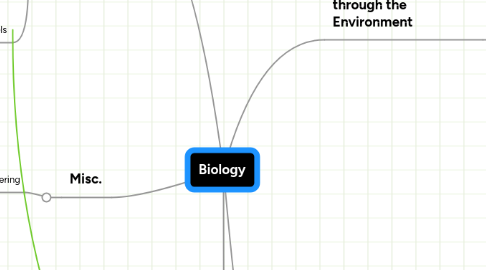
1. Ecology
1.1. Lure
1.1.1. Concealment
1.1.2. Scare
1.1.3. Decoy
1.2. Relationships
1.2.1. How organism A lives with organism B
1.2.2. Symbiosis
1.2.2.1. Mutalism
1.2.2.1.1. Both benefit
1.2.2.2. Commensalism
1.2.2.2.1. One benefits, the other has no harm nor benefit
1.2.2.3. Parasitism
1.2.2.3.1. One benefits from the other
1.3. Factors
1.3.1. Abiotic
1.3.1.1. Non-living
1.3.1.1.1. E.g. The enviroment
1.3.2. Biotic
1.3.2.1. Living
1.3.2.1.1. E.g. animals
1.4. Trophic Levels
2. Misc.
2.1. Answering
2.1.1. Drawing
2.1.1.1. Draw within the box
2.1.1.2. Show differences(e.g. shape, color, margin, venation type [variables])
2.1.1.3. Use sharp, easy to erase pencils
2.1.1.4. Draw only what is relevant
2.1.1.5. NO descriptions
2.1.1.6. Every drawing must have a title
2.1.2. Dichotomous key
2.1.2.1. Have what you listed on your drawing
2.1.2.2. Have as many levels as features
2.1.2.3. Try not to draw "V"
2.1.3. Open-Ended
2.1.3.1. Write within the lines
3. Flow of Energy/Matter through the Environment
3.1. Photosynthesis (Starts the flow of energy)
3.1.1. Point Form
3.1.1.1. REACTANTS Carbon Dioxide and Water under CONDITIONS of Light Energy and chlorophyll results in PRODUCTS of glucose and oxygen
3.1.2. Equation
3.1.2.1. Word
3.1.2.1.1. Carbon dioxide + water-(Sunlight and chlorophyl)-> glucose +oxygen
3.1.2.2. Chemical
3.1.2.2.1. 6CO2 + 12H2O -(Sunlight and chlorophyl)-> C6H12O6 + 6O2 + 6H2O
3.1.2.2.2. Metabolic Reaction
3.1.3. Paragraph Form
3.1.3.1. a process whereby light energy is trapped by chlorophyll and converted into chemical energy which is then utilized to manufacture carbohydrates/glucose from raw materials such as carbon dioxide and water. Oxygen is released as a by-product
3.1.4. Performing Starch test
3.1.4.1. Place leaf in boiling water to kill the cell and tear open the cell membranes so the iodine stain can easily enter the cells. Place leaf in boiling alcohol to remove the green chlorophyll so the final results can be clearly seen Dip leaf into warm water to remove the alcohol so the iodine stain can penetrate the leaf. Cover leaf with iodine solution to test for the presence of starch. Those parts of the leaf that stain blue-black contain starch. Those parts that are yellow-brown (the colour of the iodine stain) do not have starch.
3.2. Cycles
3.2.1. Food Chains
3.2.1.1. Is a series of organisms through which energy is trasnferred in material form
3.2.1.2. should have only 4 trophic levels
3.2.1.2.1. 1st Trophic level
3.2.1.2.2. 2nd Trophic level
3.2.1.2.3. 3rd Trophic level
3.2.1.2.4. 4th Trophic level
3.2.1.2.5. possible 5th Trophic level
3.2.1.3. Energy Loss
3.2.1.3.1. A lot of energy is lost through the trophic levels
3.2.1.3.2. Due to Life Processess
3.2.1.4. Ecological Pyramids
3.2.1.4.1. graphical representation
3.2.2. Food web
3.2.2.1. An interconnection of several food chains at many points
3.2.3. Pyramids
3.3. Terms
3.3.1. Food Chain
3.3.2. Food Web
3.3.3. Pyramids
3.3.4. Trophic levels
3.3.5. Producers/Consumers
3.3.6. Process
3.3.6.1. input-->output
3.4. Energy
3.4.1. Living organisms need it
3.4.1.1. perform various vital functions
3.4.1.2. to live
3.4.2. Plants
3.4.2.1. Energy comes from the sun
3.4.2.1.1. Autotrophic nutrition
3.4.3. Animals
3.4.3.1. Heterotrophic nutrition
3.4.3.1.1. process whereby an organsism uses organic compounds for most or all of its actions
3.5. Molecular Transports
3.5.1. Osmosis
3.5.2. Diffusion
3.6. The Sun
3.7. Modes Of Nutrition (Trophic Levels)
3.7.1. Autotrophs
3.7.1.1. Definition
3.7.1.1.1. Producers
3.7.1.1.2. a PROCESS
3.7.1.2. Chemoautotrophs
3.7.1.2.1. An organism (typically a bacterium or a protozoan) that obtains energy through chemical process
3.7.1.3. Photoautotrophs
3.7.1.3.1. An organism, typically a plant, obtaining energy from sunlight as its source of energy to convert inorganic materials into organic materials.
3.7.2. Hetrotrophs
3.7.2.1. Definition
3.7.2.1.1. Consumers
3.7.2.1.2. a PROCESS
3.7.2.2. Holotroph
3.7.2.2.1. Organisms that are capable of consuming other organisms in whole.
3.7.2.3. Saprotrophs
3.7.2.3.1. An organism(most often associated to fungi) that is involved in the processing of dead or decayed organic matter.
4. Biodiversity
4.1. 5 Kingdoms
4.1.1. Animalia
4.1.2. Plantae
4.1.3. Monera
4.1.4. Protista
4.1.5. Fungi
